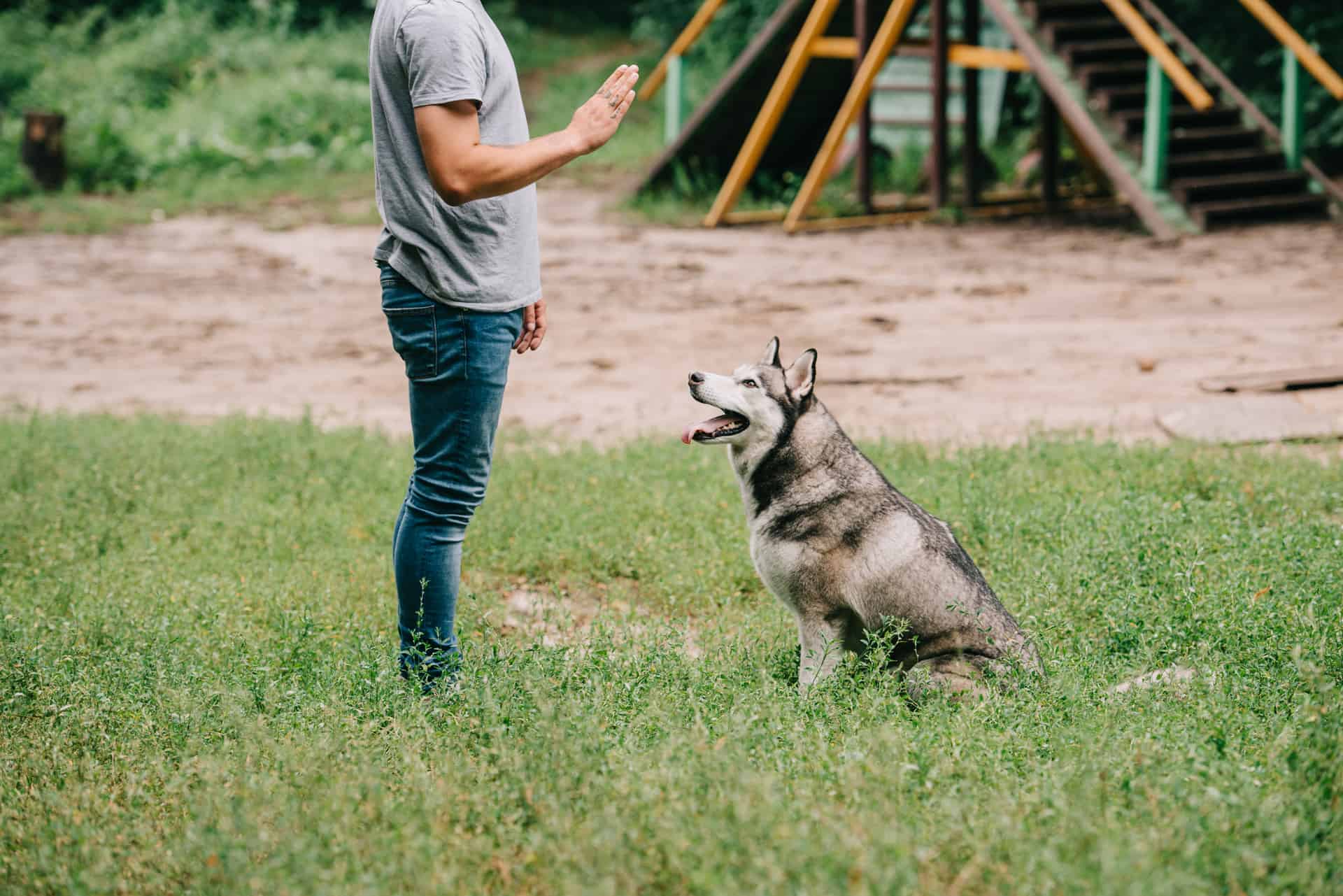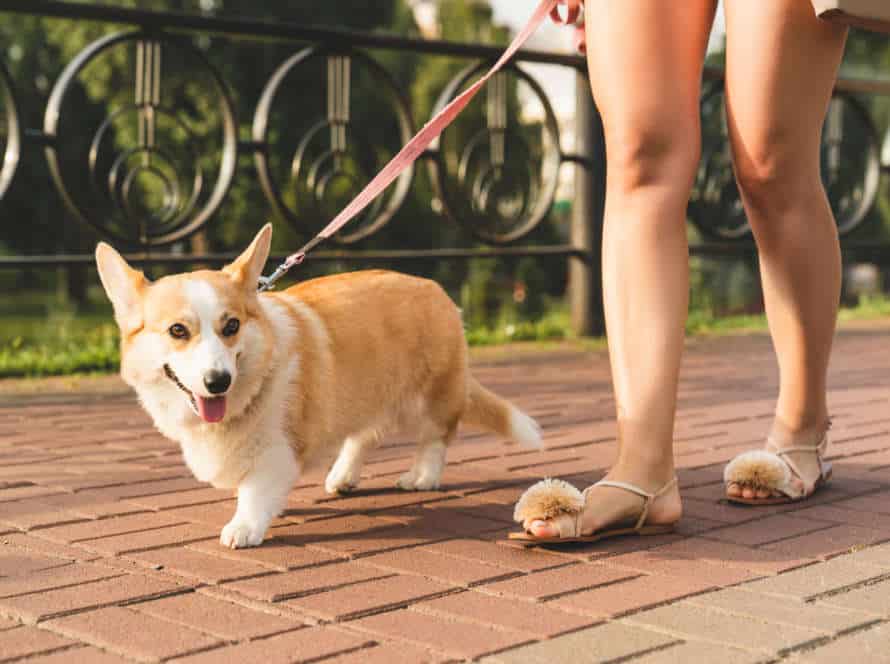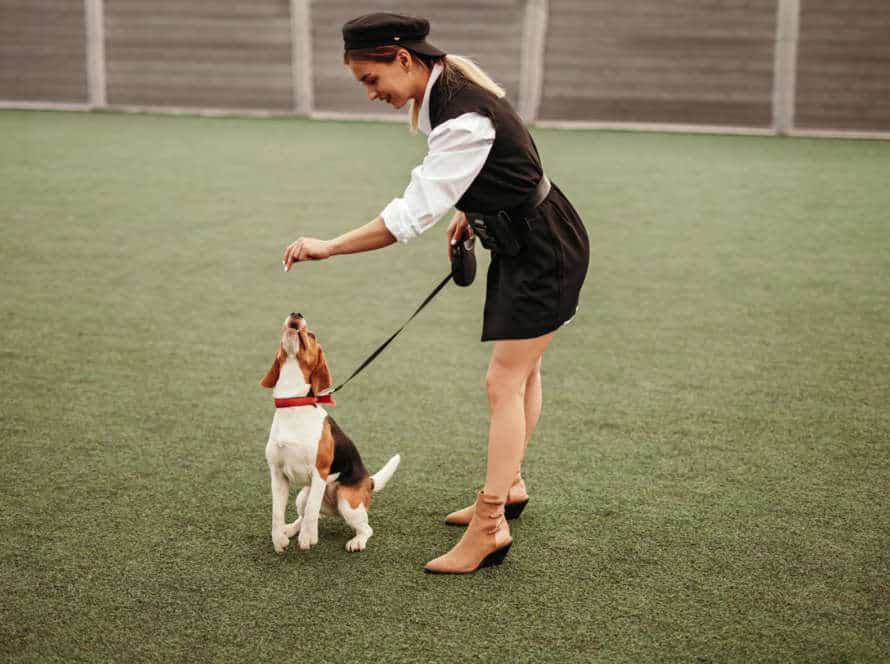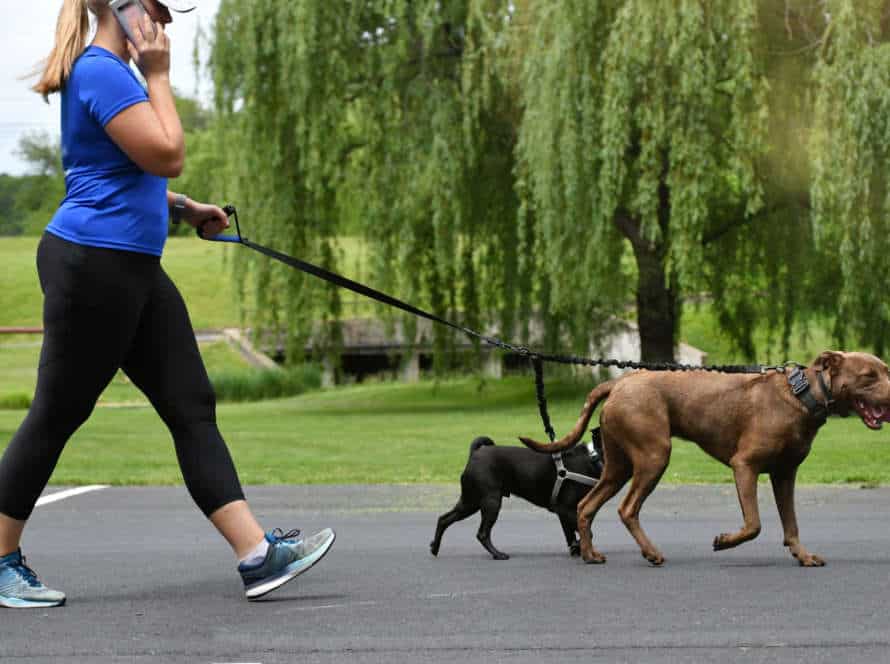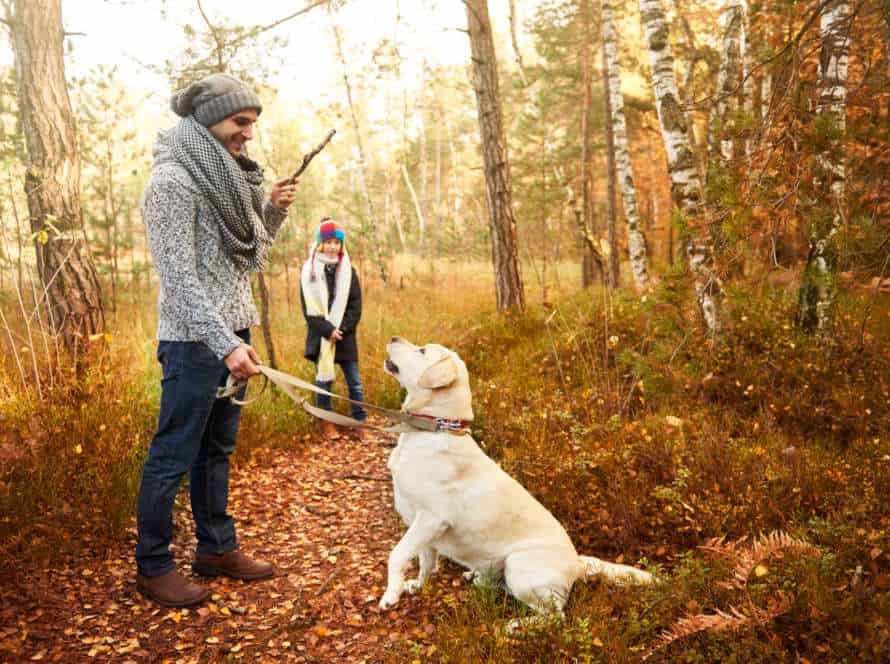The Sit Command: Foundation for Your Dog’s Training Journey
The sit command is essential! It’s the basis of many other commands, and helps you be the alpha. Here’s how to teach it:
- Hold a treat by your dog’s nose.
- Move it slowly up.
- Your dog’s head will follow, and its butt will lower.
- Say ‘sit’ as soon as its butt hits the floor. Give the treat as a reward.
- Practice daily – with and without treats, in different environments.
- Short and frequent training sessions are key!
Understanding the Sit Command
Sit is a must-know command for dogs! It’s the start of their training journey. Knowing how to teach them this command is key for more advanced commands later. Let’s look into how to teach them the Sit command.
What is the Sit Command?
The Sit Command is an important basic obedience skill used to train dogs. It helps with safety and communication. To teach your pup: start with them standing facing you. Hold a treat in front of their nose. Move it slowly upwards. They’ll sit down to keep their eyes on the treat. Reward them with the treat and praise. Practice daily. And, replace the treat with verbal praise and affection. The Sit Command is a great foundation for more advanced commands and behaviors like ‘Stay‘, ‘Come‘, and ‘Heel‘.
Why is the Sit Command Important?
The Sit command is a must-have! It’s key to your pup’s training journey. It teaches discipline and good behavior, plus it helps you show your pup who’s boss. It also encourages social interaction, like sitting when strangers or other dogs are around. Teaching this command sets the groundwork for future training, and helps create a strong bond between you and your pup. So, teach your pup the Sit command – it’s essential!
How Does the Sit Command Fit into Your Dog’s Training Journey?
The ‘sit’ command is very important in a dog’s training. It serves as the base for other commands, like ‘stay’ and ‘come’. So, understanding how to teach ‘sit’ is key for successful training. Follow these steps:
- Hold a treat close to your pup’s nose.
- Move your hand up, so their head follows it, making their bottom lower.
- Say ‘sit’ and give them the treat when they do it.
- Repeat this several times, with no treat and use hand signals and verbal cues.
- Be consistent with the training and reward your dog every time they do it right – use positive reinforcement.
With patience and practice, your dog will master the ‘sit’ command and be ready for more complex training.
Teaching Your Dog the Sit Command
Teach your pup the sit command! It’s a key step in basic dog training. It’s easy to learn and can help with other commands. Teaching your dog the sit command is also important for their safety. Here’s how to do it:
Preparing for Training
Teaching your pup to sit is important. It’s the base of all dog training. Here’s how to be ready for training your dog to sit:
- Pick a nice spot. A quiet area with no distractions is best. This helps your pup stay focused on the training.
- Get the tools. Treats, clickers, and whistles are common. Consider your pup’s temperament and response when deciding on tools.
- Timing matters. For the sit command, hold a treat near your pup’s nose and raise it above their head. Command “Sit” in a firm but friendly voice. As your pup goes for the treat, their hips will smoothly fall into a sitting position. Say “Sit” again, click or whistle, and give them the treat.
Training your pup can be fun! Follow these steps to make it efficient and effective.
Teaching the Sit Command
Teaching a pup the “sit” command is critical in dog training. Here’s how to do it:
- Hold a yummy treat near your pup’s snout and move it slowly up and back. Your pup should follow the treat with its head, and its bottom will lower to the ground.
- Once your pup’s bottom is on the floor, say “sit” and present the treat as a reward.
- Do this several times. As you go, gradually stop using treats and keep reinforcing the command with praise and love.
- Practice the command in different spots, with more distractions each time.
The “sit” command not only shows your pup it should listen to you and obey your orders, but also strengthens your bond. By consistently reinforcing the “sit” command, your pup will recognize you as leader.
Positive Reinforcement Techniques for Successful Training
Positive reinforcement is an effective way to train pets. Teaching your pup the sit command is a great start. Here’s some tips for success:
- Treats: Hold one in your hand and move it in front of their nose. Gradually raise it higher, encouraging them to sit. When they do, reward them with a treat and kind words.
- Verbal Cues: Use simple and consistent language. Say “sit” clearly and confidently while guiding them into the position.
- Timing: Give reward immediately after they do the desired action. This helps them understand the connection between behavior and reward.
- Persistence: Training takes patience and repetition. Train multiple times a day until they respond consistently. Gradually reduce the treats as they become more comfortable.
Remember, positive reinforcement is a powerful tool. With patience and consistency, it can help you build a strong bond. Pro tip: Be consistent and stay positive. This will help speed up learning.
Using the Sit Command in Real Life Situations
Teach your pup the Sit command! It’s fundamental for the rest of their training. You can use this command in various situations. In this article, we’ll tell you how it can help you and your pup in their everyday life.
Teaching Your Dog to Sit on Command: Outside
Train your pooch to sit on command! It’s key when you begin their training. Try these tips to make it real:
- Begin in the house with minimal distractions then step it up.
- During walks, use the command around pedestrian crossings and other potential dangers.
- Utilize it when playing outside or welcoming visitors.
Reward them with treats or their favorite toy when they obey. Patience and consistency will help them learn. Don’t punish them if they don’t obey. Take goodies with you when you go out – it’ll motivate them and reinforce good behavior.
Teaching Your Dog to Sit on Command: Inside
Teach your pup to sit on command! It’s a key step in their training, and can be easily done in a few measures. Once your pup has it down, the uses for it are infinite – so it’s an essential part of the training process!
Here are some typical scenarios where a “sit” command is invaluable:
- At mealtime – Get your pup to sit before you put down the food bowl – no jumping or barking!
- At the door – Make your pup sit when you open the door. Keep them from running outside and getting hurt.
- Introducing new people – Ask your pup to sit when someone greets them. Makes it much nicer for everyone.
- When crossing roads – Get your pup to sit at the curb before you cross the road. Keeps them safe.
All in all, teaching your pup to sit on command is an essential part of the training. It’s useful in lots of real-life situations, to keep both you and your pup happy and secure.
Using the Sit Command to Enhance Your Dog’s Life
The “Sit” command can make a big difference in your pup’s life! It’s a great starting skill for training, behavior change, and bonding. Here are three practical ways to use it:
- Greeting visitors? Have your doggo “Sit” before they say hi. This will stop jumping and too much excitement.
- Mealtime? Teach your pup to “Sit” and wait before eating. This reinforces good behavior and makes meals more pleasant.
- Street crossings? Use the “Sit” command before crossing streets or intersections. That way, your pup remains calm and obedient – and safe!
Let “Sit” be the foundation of a happy, well-behaved life with your furry buddy.
Troubleshooting Common Problems with the Sit Command
Teaching your pup the Sit Command is essential for their obedience training. Yet, it can be challenging to learn. It’s a typical issue that many dog owners need help with.
We’ll go over some of the most usual difficulties you might have when teaching your dog the Sit command and how to solve them.
My Dog Won’t Sit
The sit command is the starting point of a dog’s training. It’s essential to solve problems that may arise when teaching them. Here are some reasons why your dog doesn’t respond:
- Intimidation: If your pup is scared, they won’t sit. Make a calmer atmosphere and reward them with positive reinforcement.
- Distraction: If playing or exploring is more interesting, they won’t sit. Train in a quiet place and give them treats or toys to refocus.
- No understanding: Maybe your pup doesn’t get it. Repeat the training with clear instructions and practice more.
- Medical issues: If they’re in pain or uncomfortable, they won’t sit. Visit the vet to check for any medical issues.
Being patient and consistent will help them understand and obey the sit command. This sets them up for success in future training.
My Dog Won’t Stay Seated
If your pup won’t stay seated, there are a few issues you can troubleshoot. Here’s how to train them:
- Find a quiet and undistracted area.
- Use treats to lure them into the seated position.
- Place it above their nose to get them to look up.
- Use a clear voice command, like “sit“.
- If they still won’t sit, try switching locations or adjusting the treat’s height.
The “sit” command is important for training. Be patient and consistent with your approach to better understand your pup’s needs.
Sit Command Challenges with Puppies
Teaching a pup to sit is a basic command that forms a strong base for more obedience instruction. Yet, many new puppy parents often have challenges attempting to educate this command. Here are some regular issues that new dog owners go through while teaching the Sit command and how to tackle them:
- The pup is too distracted: If your pup is too preoccupied, try practicing the sit command in a secure, low-distraction atmosphere. Step by step, rise the amount of distraction over time.
- The puppy doesn’t maintain the position: If your pup doesn’t stick to the place, try luring them with a treat or plaything to keep their attention. Reward your pup each time they perform the sit command properly.
- The pup jumps up instead of sitting: If your pup jumps up rather than sitting, try taking a step back and enticing the pup with the treat again. Utilize a firmer voice command like “no” or “off” to state that jumping up is not allowed.
Mastering the sit command is just the initial step in your dog’s training journey. With consistent practice and patience, your pup will become an obedient pet.
Building on the Sit Command for Further Training Goals
Train your pup with the fundamental sit command! It’s key for starting a great relationship and teaching them the ‘language’ of training. But, sit isn’t the be-all, end-all. Use it to lay the foundation for more training goals!
The Sit Command as a Foundation for Advanced Training
The “Sit” command is essential for dog training. It forms the basis of more complex commands. Once your dog has learned to “Sit“, you can go ahead and teach:
- “Stay” after the “Sit” command.
- “Heel” where the dog walks next to you.
- “Come” to get your dog to come to you.
- “Down” to make your dog lie down from the sitting position.
- “Quiet” to stop barking.
The “Sit” command is a key part of training. It unlocks the door to a lot of commands, so you can have an obedient dog. Pro tip: Keep training consistent and rewarding to avoid confusion and foster good behavior.
Other Commands to Build on the Sit Command
The ‘Sit’ command is a must for your pup’s training. Once they’ve got it, you can try other commands. These include: ‘Stay’, ‘Lay down’, ‘Come’, and ‘Heel’.
By adding to the Sit command and introducing new ones, you can create a great base for your dog’s training. Keep training short, and use rewards to motivate them. This will help them learn and have better behaviour!
Incorporating the Sit Command into Dog Sports or Activities
The “sit” command is the basis of your pup’s learning experience. It can help reach further goals and do dog activities. Here are some examples:
- Agility: Teach your dog to sit at start line before running.
- Obedience: Teach your dog to sit and stay while looking at you.
- Rally-O: Teach your pup to sit at halts on the course.
- Freestyle: Teach your dog to sit in tune with the music and dance moves.
“Sit” is vital for teaching more complex commands and behaviors. It builds trust, creates expectations, and creates a strong bond between you and your dog.
Frequently Asked Questions
Q: What is the sit command?
A: The sit command is a basic command used in dog training that teaches your dog to sit on command.
Q: Why is the sit command important?
A: The sit command is important because it helps establish you as the leader of your pack while also allowing your dog to develop impulse control.
Q: How do I teach my dog the sit command?
A: To teach your dog the sit command, hold a treat in front of their nose and move it upwards. This will cause your dog to lower its hindquarters and sit. Reward them with the treat and repeat the process until they learn the sit command.
Q: How long does it take to train my dog to sit on command?
A: The time it takes to train your dog to sit on command varies based on the dog and the consistency in training. With daily training sessions, your dog should be able to learn the sit command within a week or two.
Q: Should I use a clicker when training my dog to sit?
A: Using a clicker during training can be helpful to mark the desired behavior and further reinforce the sit command. However, it is not necessary and can be substituted with a verbal marker such as the word “yes” or “good”.
Q: Can the sit command be used as a foundation for other commands?
A: Yes, the sit command is considered a foundation command and can be built upon with other commands such as stay, come, and down.

